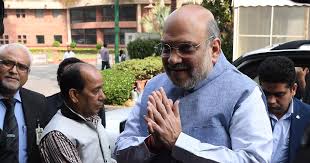Entertainment
Huge audience for Indian classical music abroad: Anoushka Shankar

By Ankit Sinha
New Delhi: Internationally acclaimed sitarist Anoushka Shankar says Indian classical music has a strong following abroad, but it’s “such a shame” that the genre’s popularity hasn’t translated in the country of its origin.
The daughter of late sitar maestro Pandit Ravi Shankar earned her fifth Grammy nomination this week for her album “Home”, which reaffirms Indian classical music’s hold in the West.
“I think our music in its purest form is something what we always talk about here as being under threat. I see that less for myself because I don’t come here that often, but I see my peers who say that they have to do collaborations and crossover fusion, and some kind of spin for it to sell,” Anoushka, who is in the capital to perform a concert on Sunday evening, told in a candid tete-a-tete.
“That’s such a shame because there is a huge audience for our music abroad. I tour around the world, the classical shows would totally sell out. There is a huge audience for what we have to offer. It’s a shame that it is not translating in the country of its origin,” she added.
She says that the “narrow stream of media” here makes it seem that Indian classical music is under some “threat”, but that’s not entirely true.
“We have a narrow stream of media and it’s really prominent and therefore it seems like Indian music is under threat, because it is not very visible. There is only one genre that’s really visible. But if you go to any classical festivals in any of the cities, it is amazing, it is beautiful. There are thousands of people listening all night,” she said.
While she doesn’t like the comparison between India and the West, Anoushka, who resides in London, would like to take the positives from the western outlook towards music.
“I don’t like the Indian and western comparisons, but the one thing I do like to take note of is that in the West, there is a space created for every genre so it’s allowed to exist on its own.
“Opera has opera houses, classical music has symphony halls, electronic music has clubs, rock music has stadiums. Everyone has got their space and there is sponsorship, donorship, support, radio channels for each genre. There is a setup for each thing and people can go for what they want,” she added.
She praised the Indian government for providing support to classical music and the arts, but lamented the lack of venues and media viability in the country.
“India does have a lot of governmental support for classical music and the arts, but it is not about that. Where are the concert halls? Where are the venues? Where are the radio stations? Where are the TV channels? That’s where the problem lies a lot more than how many people listen to it,” she said.
So, what, in her opinion, is the solution?
“If people within the classical music world could get some help in how to develop visibility in other media, whether it is streaming concerts live on subscription channels online for example… Anything that does it without diluting content is a priority,” she said, while adding that private funding and donorship can also propel the music’s growth.
“We rely on corporate sponsorship here. It has its place, but some private donors would be really helpful,” she added.
For centuries, art and music have helped establish a spiritual connection between humans irrespective of their race or ethnicity. Anoushka says that music helps us to “reconnect to exalted, higher places” that are beyond all arguments.
“Music is where you can put words and belief systems aside and just connect heart-to-heart. You and I know, two people can connect from the heart… If you are not talking politics, you are not talking religion, you can still connect,” she said.
“Music has always played a role because it helps reconnect back to more exalted, higher places beyond all other arguments and I think that’s something that it is really important.”
Entertainment
Casino Days Reveal Internal Data on Most Popular Smartphones

International online casino Casino Days has published a report sharing their internal data on what types and brands of devices are used to play on the platform by users from the South Asian region.
Such aggregate data analyses allow the operator to optimise their website for the brands and models of devices people are actually using.
The insights gained through the research also help Casino Days tailor their services based on the better understanding of their clients and their needs.
Desktops and Tablets Lose the Battle vs Mobile
The primary data samples analysed by Casino Days reveal that mobile connections dominate the market in South Asia and are responsible for a whopping 96.6% of gaming sessions, while computers and tablets have negligible shares of 2.9% and 0.5% respectively.
The authors of the study point out that historically, playing online casino was exclusively done on computers, and attribute thе major shift to mobile that has unfolded over time to the wide spread of cheaper smartphones and mobile data plans in South Asia.
“Some of the reasons behind this massive difference in device type are affordability, technical advantages, as well as cheaper and more obtainable internet plans for mobiles than those for computers,” the researchers comment.
Xiaomi and Vivo Outperform Samsung, Apple Way Down in Rankings
Chinese brands Xiaomi and Vivo were used by 21.9% and 20.79% of Casino Days players from South Asia respectively, and together with the positioned in third place with a 18.1% share South Korean brand Samsung dominate the market among real money gamers in the region.
Cupertino, California-based Apple is way down in seventh with a user share of just 2.29%, overshadowed by Chinese brands Realme (11.43%), OPPO (11.23%), and OnePlus (4.07%).
Huawei is at the very bottom of the chart with a tiny share just below the single percent mark, trailing behind mobile devices by Motorola, Google, and Infinix.
The data on actual phone usage provided by Casino Days, even though limited to the gaming parts of the population of South Asia, paints a different picture from global statistics on smartphone shipments by vendors.
Apple and Samsung have been sharing the worldwide lead for over a decade, while current regional leader Xiaomi secured their third position globally just a couple of years ago.
Striking Android Dominance among South Asian Real Money Gaming Communities
The shifted market share patterns of the world’s top smartphone brands in South Asia observed by the Casino Days research paper reveal a striking dominance of Android devices at the expense of iOS-powered phones.
On the global level, Android enjoys a comfortable lead with a sizable 68.79% share which grows to nearly 79% when we look at the whole continent of Asia. The data on South Asian real money gaming communities suggests that Android’s dominance grows even higher and is north of the 90% mark.
Among the major factors behind these figures, the authors of the study point to the relative affordability of and greater availability of Android devices in the region, especially when manufactured locally in countries like India and Vietnam.
“And, with influencers and tech reviews putting emphasis on Android devices, the choice of mobile phone brand and OS becomes easy; Android has a much wider range of products and caters to the Asian online casino market in ways that Apple can’t due to technical limitations,” the researchers add.
The far better integration achieved by Google Pay compared to its counterpart Apple Pay has also played a crucial role in shaping the existing smartphone market trends.
Content provided by Adverloom

























